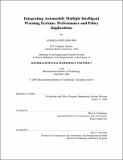Integrating Automobile Multiple Intelligent Warning Systems : Performance and Policy Implications
Author(s)
Ho, Angela Wei Ling
DownloadHAL2006-08.pdf (4.614Mb)
Other Contributors
Massachusetts Institute of Technology. Dept. of Aeronautics and Astronautics. Humans and Automation Laboratory
Metadata
Show full item recordAbstract
Intelligent driver warning systems can be found in many high-end vehicles on the road today,
which will likely rapidly increase as they become standard equipment. However, introducing multiple
warning systems into vehicles could potentially add to the complexity of the driving task, and there are
many critical human factors issues that should be considered, such as how the interaction between
alarm alerting schemes, system reliabilities, and distractions combine to affect driving performance
and situation awareness. In addition, there are also questions with respect to whether there should be
any minimum safety standards set to ensure both functional and usage safety of these systems, and
what these standards should be.
An experiment was conducted to study how a single master alert versus multiple individual
alerts of different reliabilities affected drivers’ responses to different imminent collision situations
while distracted. A master alert may have advantages since it reduces the total number of alerts, which
could be advantageous especially with the proliferation of intelligent warning systems. However, a
master alert may also confuse drivers, since it does not warn of a specific hazard, unlike a specific
alert for each warning systems. Auditory alerts were used to warn of imminent frontal and rear
collisions, as well as unintentional left and right lane departures. Low and high warning reliabilities
were also tested. The different warning systems and reliability factors produced significantly different
reaction times and response accuracies. The warning systems with low reliability caused accuracy rates to fall more than 40% across the four warning systems. In addition, low reliability systems also
induced negative emotions in participants. Thus, reliability is one of the most crucial determinants of
driving performance and the safety outcome, and it is imperative that warning systems are reliable. For
the master versus distinct alarms factor, drivers responded statistically no different to the various
collision warnings for both reaction times and accuracy of responses. However, in a subjective postexperiment
assessment, participants preferred distinct alarms for different driver warning systems,
even though their objective performance showed no difference to the different alerting schemes.
This study showed that it was essential to design robust and reliable intelligent warning
systems. However, there are no existing safety standards today to ensure that these systems are safe
before they are introduced into vehicles, even though such systems are already available in high-end
cars. Even though there are tradeoffs in having standards, such as increased time-to-market and
possible loss of innovation, I recommend that safety standards be set nonetheless, since standards will
ensure the safety performance of warning systems, to an extent. In terms of functional safety, safety
standards should be performance-based, and should specify a minimum level of reliability. In terms of
usage safety, the standards should also be performance-based, where driving performance can be
indicated by measures such as reaction time, lane position, heading distance and accuracy of
responses. In addition, multiple threat scenarios should also be tested. In terms of design guidelines,
the various human factors guidelines from different countries should be harmonized internationally to
ensure that manufacturers have access to a consistent set of guidelines. Finally, it is also important that
these standards, especially for usage safety, specify tests with not just the average driver, but also with
peripheral driving populations including novice and elderly drivers.
Date issued
2006Publisher
MIT Humans and Automation Laboratory
Series/Report no.
HAL Reports;HAL2006-08